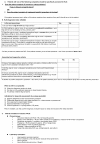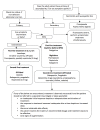Algorithms for the diagnosis and treatment of restless legs syndrome in primary care
- PMID: 21352569
- PMCID: PMC3056753
- DOI: 10.1186/1471-2377-11-28
Algorithms for the diagnosis and treatment of restless legs syndrome in primary care
Abstract
Background: Restless legs syndrome (RLS) is a neurological disorder with a lifetime prevalence of 3-10%. in European studies. However, the diagnosis of RLS in primary care remains low and mistreatment is common.
Methods: The current article reports on the considerations of RLS diagnosis and management that were made during a European Restless Legs Syndrome Study Group (EURLSSG)-sponsored task force consisting of experts and primary care practitioners. The task force sought to develop a better understanding of barriers to diagnosis in primary care practice and overcome these barriers with diagnostic and treatment algorithms.
Results: The barriers to diagnosis identified by the task force include the presentation of symptoms, the language used to describe them, the actual term "restless legs syndrome" and difficulties in the differential diagnosis of RLS.
Conclusion: The EURLSSG task force reached a consensus and agreed on the diagnostic and treatment algorithms published here.
Figures
Similar articles
-
Diagnostic standards for dopaminergic augmentation of restless legs syndrome: report from a World Association of Sleep Medicine-International Restless Legs Syndrome Study Group consensus conference at the Max Planck Institute.Sleep Med. 2007 Aug;8(5):520-30. doi: 10.1016/j.sleep.2007.03.022. Epub 2007 Jun 1. Sleep Med. 2007. PMID: 17544323
-
Guidelines for the first-line treatment of restless legs syndrome/Willis-Ekbom disease, prevention and treatment of dopaminergic augmentation: a combined task force of the IRLSSG, EURLSSG, and the RLS-foundation.Sleep Med. 2016 May;21:1-11. doi: 10.1016/j.sleep.2016.01.017. Epub 2016 Feb 23. Sleep Med. 2016. PMID: 27448465
-
Evidence-based and consensus clinical practice guidelines for the iron treatment of restless legs syndrome/Willis-Ekbom disease in adults and children: an IRLSSG task force report.Sleep Med. 2018 Jan;41:27-44. doi: 10.1016/j.sleep.2017.11.1126. Epub 2017 Nov 24. Sleep Med. 2018. PMID: 29425576
-
Clinical trials in restless legs syndrome--recommendations of the European RLS Study Group (EURLSSG).Mov Disord. 2007;22 Suppl 18:S495-504. doi: 10.1002/mds.21538. Mov Disord. 2007. PMID: 17530666
-
The long-term treatment of restless legs syndrome/Willis-Ekbom disease: evidence-based guidelines and clinical consensus best practice guidance: a report from the International Restless Legs Syndrome Study Group.Sleep Med. 2013 Jul;14(7):675-84. doi: 10.1016/j.sleep.2013.05.016. Sleep Med. 2013. PMID: 23859128
Cited by
-
Assessing Cognitive Behavioral Therapy for Insomnia to Improve Sleep Outcomes in Individuals With a Concussion: Protocol for a Delayed Randomized Controlled Trial.JMIR Res Protoc. 2022 Sep 23;11(9):e38608. doi: 10.2196/38608. JMIR Res Protoc. 2022. PMID: 36149737 Free PMC article.
-
Transdermal rotigotine for the perioperative management of restless legs syndrome.BMC Neurol. 2012 Sep 25;12:106. doi: 10.1186/1471-2377-12-106. BMC Neurol. 2012. PMID: 23009552 Free PMC article. Clinical Trial.
-
The Effect of Gabapentin Enacarbil on Pain Associated with Moderate-to-Severe Primary Restless Legs Syndrome in Adults: Pooled Analyses from Three Randomized Controlled Trials.CNS Drugs. 2016 May;30(5):443-54. doi: 10.1007/s40263-016-0333-8. CNS Drugs. 2016. PMID: 27095237
-
A comparison of diabetes self-care behavior in people with type 2 diabetes with and without insomnia symptoms.Acta Diabetol. 2020 Jun;57(6):651-659. doi: 10.1007/s00592-019-01470-y. Epub 2020 Jan 7. Acta Diabetol. 2020. PMID: 31909434
-
Presenting features of idiopathic versus secondary restless legs syndrome in pregnancy.Iran J Neurol. 2014 Oct 6;13(4):241-4. Iran J Neurol. 2014. PMID: 25632338 Free PMC article.
References
-
- Kushida CA, Nichols DA, Simon RD, Young T, Grauke JH, Britzmann JB, Hyde PR, Dement WC. Symptom-Based Prevalence of Sleep Disorders in an Adult Primary Care Population. Sleep & breathing = Schlaf & Atmung. 2000;4(1):9–14. - PubMed
-
- Baos Vicente V, Grandas Perez F, Kulisevsky Bojarski J, Lahuerta Dal-Re J, Luquin Piudo R, Cummings Donadio P, Delgado Nicolas MA, Ibanez Bernabeu V, Iglesias Rodal M, Jover Blanca A. et al.[Restless legs syndrome: detection, diagnosis, impact on health and utilization of health care resources.] Rev Clin Esp. 2009;209(8):371–381. doi: 10.1016/S0014-2565(09)72340-9. - DOI - PubMed
-
- O'Keeffe ST, Egan D, Myers A, Redmond S. The frequency and impact of restless legs syndrome in primary care. Irish medical journal. 2007;100(7):539–542. - PubMed
Publication types
MeSH terms
LinkOut - more resources
Full Text Sources
Other Literature Sources
Medical




